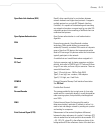
Glossary
GL-13
Open Data-Link Interface (ODI) Novell’s driver specification for an interface between
network hardware and higher-level protocols. It supports
multiple protocols on a single NIC (Network Interface
Controller). It is capable of understanding and translating
any network information or request sent by any other ODI-
compatible protocol into something a NetWare client can
understand and process.
Open System Authentication Open System authentication is a null authentication
algorithm.
PAN
Personal area network. Using Bluetooth wireless
technology, PANs enable devices to communicate
wirelessly. Generally, a wireless PAN consists of a dynamic
group of less than 255 devices that communicate within
about a 33-foot range. Only devices within this limited area
typically participate in the network.
Parameter A variable that can have different values assigned to it.
PC Card A plug-in expansion card for laptop computers and other
devices, also called a PCMCIA card. PC Cards are 85.6mm
long x 54 mm wide, and have a 68 pin connector. There are
several different kinds:
Type I; 3.3 mm high; use - RAM or Flash RAM
Type II; 5 mm high; use - modems, LAN adaptors
Type III; 10.5 high; use - Hard Disks
PCMCIA Personal Computer Memory Card Interface Association.
See PC Card.
PDT Portable Data Terminal.
Percent Decode The average probability that a single scan of a bar code
would result in a successful decode. In a well-designed bar
code scanning system, that probability should approach
near 100%.
PING (Packet Internet Groper) An Internet utility used to
determine whether a particular IP address is online. It is
used to test and debug a network by sending out a packet
and waiting for a response.
Print Contrast Signal (PCS) Measurement of the contrast (brightness difference)
between the bars and spaces of a symbol. A minimum PCS
value is needed for a bar code symbol to be scannable. PCS
= (RL - RD) / RL, where RL is the reflectance factor of the
background and RD the reflectance factor of the dark bars.


















